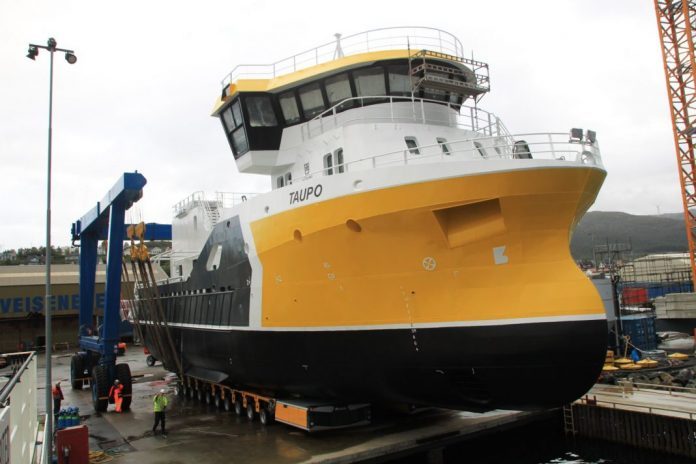“Taupo” will be ready for SalMar on New Year’s Day 2019.
“Even though the concept isn’t new, “Taupo” will be one of the first vessels ever designed and built just for this purpose. SalMar has always been at the forefront in testing of new methods to optimise operation. We’ve seen the potential here and are eager to test it out in our own organisation,” SalMar CEO, Olav-Andreas Ervik, told SalmonBusiness.
Progress in leaps and bounds
Napier has its office premises at Langevåg, western Norway, where it has become a world leader in harvesting boat technology through the “Tauranga”. Vessel number two, “Taupo”, will soon be ready for operation. Next summer will see the launch of “Taupiri”.
“We don’t have a contract on the latter (Taupiri) yet, but are working on it,” Tufteland told SalmonBusiness.
Each successive vessel has ground-breaking technological improvements. All aspects are increasingly streamlined on each vessel. Progress is happening in leaps and bounds.

Steep curve
– How is it possible that there is such a difference between two vessels whose constructions were completed within six months of each other?
“It’s an exceptional situation. As you can see, the graph rises steeply in the beginning. From there it will flatten out. Wellboats have been developed gradually over a 40-year period, so previously, there has been little difference from one boat to another,” he said.
Both “Taupo” and “Taupiri” processing vessels are being built locally at the Mekaniske Verkstad shipyard (FMV), in Fitjar western Norway, Tufteland’s birthplace. It’s been two weeks since “Taupo” was launched, and it will be undergoing trial runs early in December, before starting its contract for SalMar from 1st January.
Making sure we’re up there with the best of them
Shipyard manager, Hugo Strand, referred to the major advances being made in marine farming service vessels, particularly with regard to technology. They started with working vessels in 2010, and signed their first agreement for wellboat construction in 2014.
“We believe there will be a demand for both wellboats and processing vessels. There is an increasing focus on fish welfare, health and quality. That’s where new tonnage, factories and methods for de-lousing appear. Developments are taking place all the time, and we don’t think we’ve seen the end of development yet. There’s a multitude of factors that motivate the build of better vessels, new solutions and better-quality equipment. We’re making sure we’re up there with the best of them,” Strand said.

SalMar CEO Ervik informed SalmonBusiness that the company had considered contracting its own processing wellboat, but ended up instead with Napier’s vessel “Taupo”.
“We found out that at this point in time we are better served with letting the people who are specialists in this area of expertise, be in charge of the building and operating of both wellboat and processing vessels,” Ervik told SalmonBusiness.
The future?
As yet they are not considering more vessels with corresponding technology. Nonetheless they are aware that this is technology that can bring about significant changes to the aquaculture industry.

Is this the future?
“Only time will tell,” said Ervik. The experience we gain from “Taupo” will in time provide a good pointer for this.”
According to Napier’s Tufteland, there is widespread interest for processing vessels, despite the “Taupiri” being – as yet – without a contract.
“There is tremendous interest. The industry is facing increasing challenges from the sea. In Western Norway we have numerous biological challenges with PD and lice treatments. Fish need to be extremely robust to withstand all this. There are also challenges in transporting live fish to the slaughter plant, where there may be PD zones and ISA in several places,” he said.

